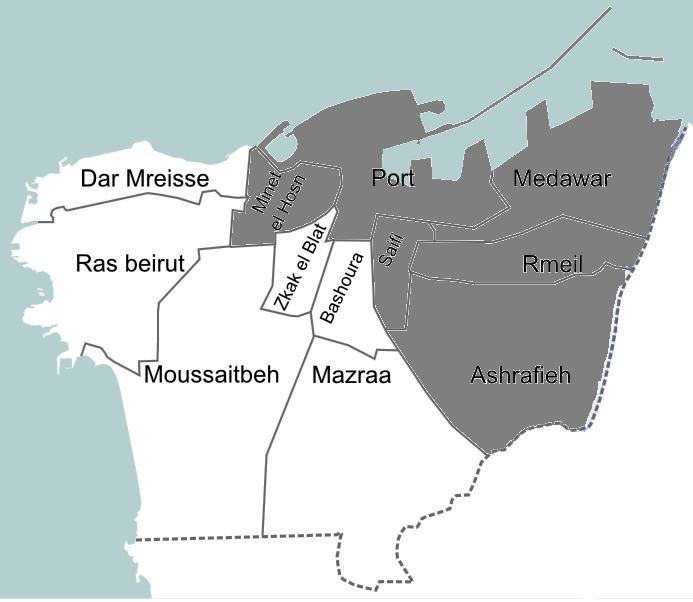 | ||
Beirut I was a parliamentary constituency in Lebanon. It covered six neighbourhoods (quartiers) of the capital; Achrafieh, Medawar, Minet El Hosn, Port, Rmeil and Saifi. It elected eight Christian parliamentarians; three Armenian Orthodox, one Armenian Catholic, one Protestant, one Maronite, one Greek Orthodox and one Greek Catholic. This constituency was used in the 1960, 1964, 1968 and 1972 elections.
Contents
1960 Election Law
The constituency was established as part of the 1960 Election Law. In the 1957 parliamentary election Beirut had been divided into two constituencies. Achrafieh, Rmeil and Saifi had been part of the Christian-dominated first district, whilst Medawar, Minet El Hosn and Port had been part of the predominantly Muslim second district. The issue of the delimitations of the Beirut constituencies had been contested, but an agreement between Christian and Muslim leaders was reached on February 23, 1960, by which there was agreement that Beirut I would be assigned eight Christian seats. The Election Law was passed in April 1960.
Demographics
On April 4, 1960 the census office published a voters list, which stated that Beirut I had 21,600 Armenian Orthodox registered voters, 16,459 Greek Orthodox, 13,654 Maronites, 8,861 Sunni Muslims, 7,403 Armenian Catholics, 5,121 Jews, 5,059 Greek Catholic, 3,161 Protestants, 2,702 Syriac Catholics, 2,200 Shia Muslims, 1,117 Latin Catholics, 748 Chaldeans, 460 Syriac Orthodox, 152 Druze and 180 persons belonging to other religious groups. Minet El Hosn hosted the majority of the Jewish community in Lebanon.
As of April 1972 it was estimated that Beirut I had 32,190 Armenian Orthodox voters, 16,709 Greek Orthodox, 13,899 Maronites, 8,046 Greek Catholics, 6,573 Sunni Muslims, 5,352 Armenian Catholics, 3,558 Jews, 3,082 Syriac Catholics, 2,749 Armenian Protestants, 2,070 Latin Catholics and 1,831 Shia Muslims.
1960 election
In the 1960 general election there were two main lists in Beirut I. The election was won by the People's List, a joint list of the Kataeb Party and the Armenian Revolutionary Federation. The main challenger had been the National Front list headed by Pierre Eddé.
1964 election
In a surprise move ahead of the 1964 general election, Camille Chamoun withdrew his candidates from Beirut I. In the end, all candidates of the Kataeb-Armenian Revolutionary Federation 'People's List' were elected unopposed.
1968 election
During the 1968 general election the electoral district had 98,439 eligible voters, out of whom 28,631 voted (29.59 percent, the lowest turn-out of all constituencies). The elections in Beirut I passed smoothly without violent incidents. The four Armenian parliamentarians were elected unopposed. Pierre Gemayel won the Maronite seat and his fellow Kataeb member Samir Ishaq won the Protestant seat. Michel Georges Sassine won the Greek Orthodox seat whilst and the Greek Catholic on Sassine's list Nasri Maalouf was also elected.
1972 election
In the 1972 general election, the last election to be held before the outbreak of the Lebanese Civil War, all candidates of the Kataeb-Armenian Revolutionary Federation-National Liberal list were elected. The main contender had been the Protestant candidate Tony Saad, who mustered 10,778 votes. 33.9 percent of the registered voters cast their ballots.
After the Civil War, a new set-up of constituencies was used ahead of the 1992 general election abolishing the 1960 Election Law constituencies.
